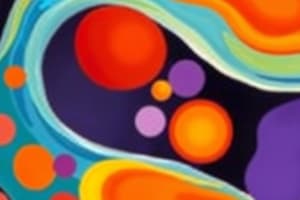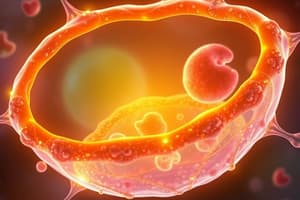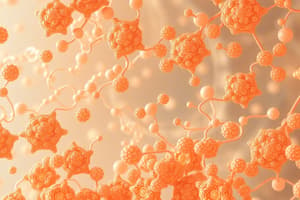Podcast
Questions and Answers
What is one of the primary functions of lipids in the human body?
What is one of the primary functions of lipids in the human body?
- To store long-term energy (correct)
- To assist in respiration
- To produce enzymes
- To store information
All fatty acids are solid at room temperature.
All fatty acids are solid at room temperature.
False (B)
What molecule is a triglyceride made of?
What molecule is a triglyceride made of?
glycerol and three fatty acids
Lipids are largely __________, meaning they do not mix with water.
Lipids are largely __________, meaning they do not mix with water.
Match the type of fatty acid with its characteristic:
Match the type of fatty acid with its characteristic:
Which of the following types of lipids is primarily used as hormones?
Which of the following types of lipids is primarily used as hormones?
Water-repelling coatings provided by lipids are not useful for feathers and leaves.
Water-repelling coatings provided by lipids are not useful for feathers and leaves.
Name a type of omega-3 fatty acid found in fish.
Name a type of omega-3 fatty acid found in fish.
What characteristic differentiates unsaturated fats from saturated fats?
What characteristic differentiates unsaturated fats from saturated fats?
Waxes are produced only by animals.
Waxes are produced only by animals.
What is the primary role of cutin on leaves?
What is the primary role of cutin on leaves?
A saturated fat is considered ‘___’ fat and is solid at room temperature.
A saturated fat is considered ‘___’ fat and is solid at room temperature.
Match the type of fat with its description:
Match the type of fat with its description:
Which type of fatty acid possesses only single bonds between carbon atoms?
Which type of fatty acid possesses only single bonds between carbon atoms?
Lipids store less energy than carbohydrates and proteins.
Lipids store less energy than carbohydrates and proteins.
What is the function of lipids in insulating the body?
What is the function of lipids in insulating the body?
Which of the following is an omega-3 fatty acid found in plants?
Which of the following is an omega-3 fatty acid found in plants?
Triglycerides are composed of a glycerol molecule bonded to ___ fatty acids.
Triglycerides are composed of a glycerol molecule bonded to ___ fatty acids.
Match the type of lipid with its primary characteristic:
Match the type of lipid with its primary characteristic:
EPA is known for promoting anti-inflammatory responses.
EPA is known for promoting anti-inflammatory responses.
What type of bond is found in unsaturated fatty acids that differentiates them from saturated fatty acids?
What type of bond is found in unsaturated fatty acids that differentiates them from saturated fatty acids?
What is the main component of the cell membrane?
What is the main component of the cell membrane?
Trans fats help maintain fluidity in cell membranes.
Trans fats help maintain fluidity in cell membranes.
Cholesterol is produced by __________ and is important for cell membrane function.
Cholesterol is produced by __________ and is important for cell membrane function.
Match the following steroids with their functions:
Match the following steroids with their functions:
Name one type of polyunsaturated omega-3 fatty acid found in fish.
Name one type of polyunsaturated omega-3 fatty acid found in fish.
What type of linkage occurs during the synthesis of triglycerides?
What type of linkage occurs during the synthesis of triglycerides?
Eicosanoids function as chemical signals between cells.
Eicosanoids function as chemical signals between cells.
What is a major consequence of excessive steroid use?
What is a major consequence of excessive steroid use?
Flashcards
What are lipids?
What are lipids?
Lipids are a diverse group of organic compounds that are essential for various biological functions.
What are lipids made of?
What are lipids made of?
Lipids are composed primarily of carbon, hydrogen, and oxygen atoms. They contain two main functional groups: carboxyl and hydroxyl groups.
Why are lipids hydrophobic?
Why are lipids hydrophobic?
Lipids are hydrophobic, meaning they repel water. This is because they have a higher proportion of nonpolar C-H bonds compared to polar hydroxyl (O-H) bonds.
What are triglycerides?
What are triglycerides?
Signup and view all the flashcards
What are saturated fatty acids?
What are saturated fatty acids?
Signup and view all the flashcards
What are unsaturated fatty acids?
What are unsaturated fatty acids?
Signup and view all the flashcards
What are cis fatty acids?
What are cis fatty acids?
Signup and view all the flashcards
What are trans fatty acids?
What are trans fatty acids?
Signup and view all the flashcards
What are waxes?
What are waxes?
Signup and view all the flashcards
What are animal waxes?
What are animal waxes?
Signup and view all the flashcards
What are plant waxes?
What are plant waxes?
Signup and view all the flashcards
What are plant waxes compared to animal waxes?
What are plant waxes compared to animal waxes?
Signup and view all the flashcards
What is cutin?
What is cutin?
Signup and view all the flashcards
DHA
DHA
Signup and view all the flashcards
ALA
ALA
Signup and view all the flashcards
Triglyceride
Triglyceride
Signup and view all the flashcards
Lipase
Lipase
Signup and view all the flashcards
Phospholipid
Phospholipid
Signup and view all the flashcards
Steroid
Steroid
Signup and view all the flashcards
Cholesterol
Cholesterol
Signup and view all the flashcards
Eicosanoid
Eicosanoid
Signup and view all the flashcards
What are some uses of lipids?
What are some uses of lipids?
Signup and view all the flashcards
What are fatty acids?
What are fatty acids?
Signup and view all the flashcards
What is a function of earwax?
What is a function of earwax?
Signup and view all the flashcards
How do plant waxes differ from animal waxes?
How do plant waxes differ from animal waxes?
Signup and view all the flashcards
Why are waxes hydrophobic?
Why are waxes hydrophobic?
Signup and view all the flashcards
Study Notes
Lipids
- Lipids are a diverse group of biological molecules, including fats, oils, waxes, and steroids
- Lipids store long-term energy, 2x more than carbohydrates/proteins
- They cushion and protect vital organs
- They are a major component of cell membranes
- Lipids are used as hormones (chemical signals)
- Lipids insulate the body against heat loss (e.g., whale blubber)
- They provide a waterproof coating for fur, feathers, and leaves
Lipid Composition
- Lipids contain carbon (C), hydrogen (H), and oxygen (O)
- Lipids have more non-polar C-H bonds and fewer polar hydroxyl (O-H) bonds
- This characteristic makes them hydrophobic, meaning they are insoluble in water but soluble in oils.
Major Lipid Types
- Triglycerides/Fats: Composed of a glycerol molecule and three fatty acids.
- Phospholipids: Major components of cell membranes, having both hydrophilic (water-loving) heads and hydrophobic (water-fearing) tails. Phospholipids form a bilayer in cell membranes.
- Steroids: Include cholesterol, testosterone, estrogen, and cortisol. Composed of four fused carbon rings. Important for hormones, membrane structure, and bile production.
- Waxes: Long fatty acid chains linked to alcohols or carbon rings, providing a hydrophobic, water-resistant layer. Examples include earwax, beeswax and cutin on leaves.
Triglycerides/Fats
- Triglycerides are formed by bonding glycerol to three fatty acids
- Fatty acids are chains of carbon atoms with a carboxyl group (COOH) at one end and a methyl group (CH3) at the other end
- Fatty acids can be saturated, unsaturated, or polyunsaturated
Saturated/Unsaturated Fats
- Saturated Fats: Have no double bonds between carbon atoms; solid at room temperature; mostly from animal sources (e.g., butter, lard).
- Unsaturated Fats: Have one or more double bonds between carbon atoms; cause kinks in the fatty acid chain; liquid at room temperature; mostly from plant sources (e.g., olive oil, vegetable oils). Unsaturated fats include both monounsaturated, having one double bond, and polyunsaturated fats, containing more than one double bond.
- Polyunsaturated are generally better for you than saturated fats because polyunsaturated fats help maintain the fluidity of cell membranes.
Cis and Trans Fats
- Cis Fats: Hydrogen atoms are on the same side of the double bond. These are generally considered part of the unsaturated fat category
- Trans Fats: Hydrogen atoms are on opposite sides of the double bond. Trans fats are created by a process called hydrogenation. Hydrogenation is a process that changes the molecular structure and can raise the melting point of liquid oils, resulting in a solid, shelf-stable fat.
Phospholipids in Cell Membranes
- Phospholipids are amphipathic, meaning they have both hydrophilic (water-loving) and hydrophobic (water-fearing) regions
- The hydrophilic heads face the water inside and outside of the cell
- The hydrophobic tails face each other, forming a barrier keeping water out. Phospholipids are crucial for the structure and function of cell membranes.
Polyunsaturated Omega-3s
- Essential fatty acids found in fish
- Include EPA (eicosapentaenoic acid) and DHA (docosahexaenoic acid)
- ALA (alpha-linolenic acid) is plant-based omega-3
- Crucial for brain development, reduce inflammation, and lower cardiovascular disease risk. Omega-3s are important for maintaining overall health.
Lipid Synthesis and Breakdown
- Lipids are synthesized by bonding fatty acids to glycerol
- Lipids are broken down by enzymes called lipases
Steroids
- Steroids are made from four linked carbon rings
- Cholesterol is a precursor to other steroids like cortisol, progesterone, estrogens, testosterone, and bile acids
- Cholesterol is important for cell membrane structure and is a precursor to several hormones. Cholesterol is essential for maintaining cell membrane fluidity and integrity.
- Cholesterol can contribute to heart disease if present in excess. Excessive cholesterol levels can lead to plaque buildup in arteries.
Eicosanoids
- Derived from arachidonic acid, a fatty acid
- Act as chemical messengers, impacting inflammation, blood clotting, hormone action, labor contractions, regulating blood vessel diameter. Important signaling molecules.
Side Effects of Steroid Abuse
- Excessive steroid use can lead to various health problems (acne, baldness, blood clots, high blood pressure, heart disease, mood swings, joint pain, etc.)
- Problematic for men and women.
- Important to note, these effects are usually observed with excessive use of steroids beyond the recommended doses and are not typical effects for proper use of these compounds.
Waxes
- Long fatty acid chains linked to alcohols or carbon rings
- Hydrophobic, firm consistency, pliable
- Produced by animals (e.g., earwax, beeswax) and plants (e.g., cutin)
Diagrams of Lipids
- Diagrams illustrate the structures of glycerol, fatty acids, saturated/unsaturated fats, phospholipids, steroids, and waxes
Studying That Suits You
Use AI to generate personalized quizzes and flashcards to suit your learning preferences.




